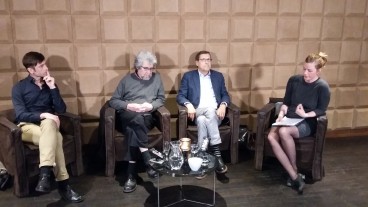The seventh debate in the Art Match series was devoted to cultural philanthropy and alternative cultural institutions, and it featured Ludvík Hlaváček, director of the Foundation for Contemporary Art Prague; Petr Tyc, chairman of the Association MOTUS and Jiří Wald, a longtime patron and co-author of the project Orbis Pictus.
Discussion revolved around the questions regarding what alternative art is, what its implications for society are and what challenges alternative artists face in the context of philanthropy.
Ludvík Hlaváček found a direct connection to alternative art with the idea from Karl Popper, an Austro-British thinker; it was one of an open society which proclaims that the administration system is imperfect and its mistakes are supposed to be corrected by the institutions established by the system. Similarly, alternative art aims to tackle shortcomings in society.
Petr Tyc stressed that alternative art is a mature form of traditional art which does not only repeat stable patterns, and he explained that the engine of alternatives is a desire to express with the current language and evolve.
“Alternative art is like a resuscitation department of culture. It provides room for development of creative abilities,” said Jiří Wald.
One of the areas for development, according to Wald, can be alternative centers where culture can grow and assert itself in its multifunctionality.
According to Ludvík Hlaváček, the nongovernmental organizations play a key role as well. In our area, they are still primarily engaged in charity, however proper culture, with an emphasis on alternative arts, also belongs in their fields of action. Such a way of managing alternatives brings a solution to the financial problems that alternative artists are forced to face. On the topic of finances, Jiří Walda explained that alternative art usually involves only a small number of people, and, therefore, it is not attractive for marketing. A typical Czech problem is that many people believe that artists live from the air and create art purely for their own pleasure.
“Freedom of culture can only be achieved if sufficiently funded,” Jiří Wald said.
Petr Tyc developed the idea that only a small part of society can perceive alternative arts. One should be unprejudiced and open-minded, able to be creative in himself. And that is in today’s world of a low-tolerance demanding. The challenge of philanthropy of alternative art is to first educate the viewer and draw them into the artistic environment. Only then is there a willingness to donate, from which patronage can be developed.
The debaters agreed that nowadays alternative art, in terms of audience, is overwhelmed by mass popular culture. Without spectators with an alternative in their hearts, no philanthropy exists. Without the necessary funds, there are no investments in marketing that would attract a larger audience with which philanthropists could be raised from. Therefore, it is necessary to seek a solution to this vicious circle.

